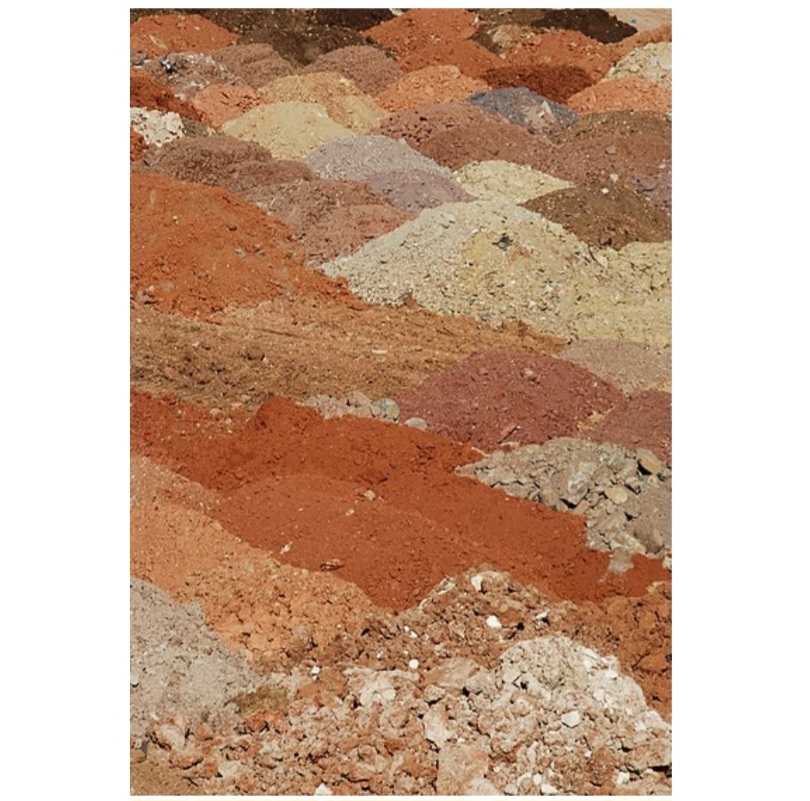
Soil is a natural body comprised of three phases. The solids phase (minerals and organic matter), liquid phase, and gaseous phase. The solid phase is made up of layers which goes deep down untill the middle of the earth called core is reached. The soil horizons, or layers can be characterized and distinguished from one another based on materials added, losses and transfered causing a change in the layer colour.
One of the physical properties used to characterize and distinguish soil types and soil profile is the soil colour. It is a property that most reflects the pedogenic environment and history of the soil. It may be inherited from the parental material (i.e., lithocentric) or sometimes may be due to soil-forming processes (acquired or genetic colour). The colour of soil renders a valuable key for the identification of soil type.
Colour is an important characteristics of the soil used in assessment and classification of soils. It is used to determine the history, chemistry and hydrology of soils. An obvious change in colour between horizons is a real indication of changes in soil properties which are the result of biological activity, water movement and weathering. Also, soil temperature can determine soil colour. For example, cooler regions tend to have grayish to black topsoil due to the accumulation of humus. In moist, warm regions, soils tend to be more yellowish-brown to red depending on the hydration of ferric oxide and extensive weathering of the soil’s parental mineral. Rapid mineralization of organic matter content in warm, moist regions result in less humus accumulation, thus, resulting in insufficient impact on soil colour ( less dark colouration of soil). Arid soils tend to be light in colour with little staining from the little organic matter content of that region, thus,the colour of the minerals are visible.
Also, during rainfall, water temporarily darkens soil colour, increasing light absorption. Apart from this, moisture can have long-term effects on soil colour. For example, under anaerobic waterlogged conditions, iron oxides is reduced to occur the ferrous state, therefore, giving the soil a subtle bluish-gray tint. A mottled rusty or streaked appearance in a grayish matrix may indicate improper drained soils. A blackish colour in the absence of organic material may indicate staining by manganese oxides.
The main pigmenting (colouring) agents in soils are organic matter, iron, and, to a lesser extent, manganese. When these agents are not covering the mineral grains, the natural colour of the grains is visible. Most mineral grains are naturally gray.
Note that two soils may have similar texture and structure yet differ in color scheme. When a soil horizon has more than one colour, the dominant colour by volume is the matrix color.
In profile descriptions, the dominant soil colour (matrix color) is used to distinguish horizons and as an indicator of SOC content, drainage conditions, aeration, iron content or mineralogy. Soil color is a diagnostic criterion throughout Soil Taxonomy
IMPORTANCE OF SOIL COLOUR
1. Colour can be a useful indicator of some of the general properties of a soil,
2. It can as well indicate some of the chemical processes that are occurring beneath the surface.
3. It is an indicator of the levels of organic matter (peats) content of the soil.
4. It is used to distinguish soil horizons.
5. It can serve as indicator of the degree of aeration or reduction within the soil.
6. Soils with brighter colour indicate well drained soils. 7. Grey colour indicate wetter soils.
8. Farmers use it as a determinant of soil fertility without carrying out soil test.
9. It can be used to determine the rock from which a soil is formed from.
10. It is used to determine an aged long waterlogged area. for example, some wetlands etc
FACTORS THAT DETERMINES SOIL COLOUR
Some factors that influence the colour of a soil include:
1. Mineral matter derived from the constituents of the parent material.
2. Organic matter.
3. The nature and abundance of iron.
4. Moisture content.
5. Redox reactions.
6. Accumulation of materials like calcium, gypsum and salts
In a well drained soil, the dominant colours are : white, red, brown and black. White indicates the predominance of silica (quartz), or the presence of salts; red indicates the accumulation of iron oxide; and brown and black indicate the level and type of organic matter. Soil organic matter and iron oxides contribute most to soil colour. Organic matter darkens soil, while iron oxides produce a range of soil colours that are dependent on the oxidation state of the iron.
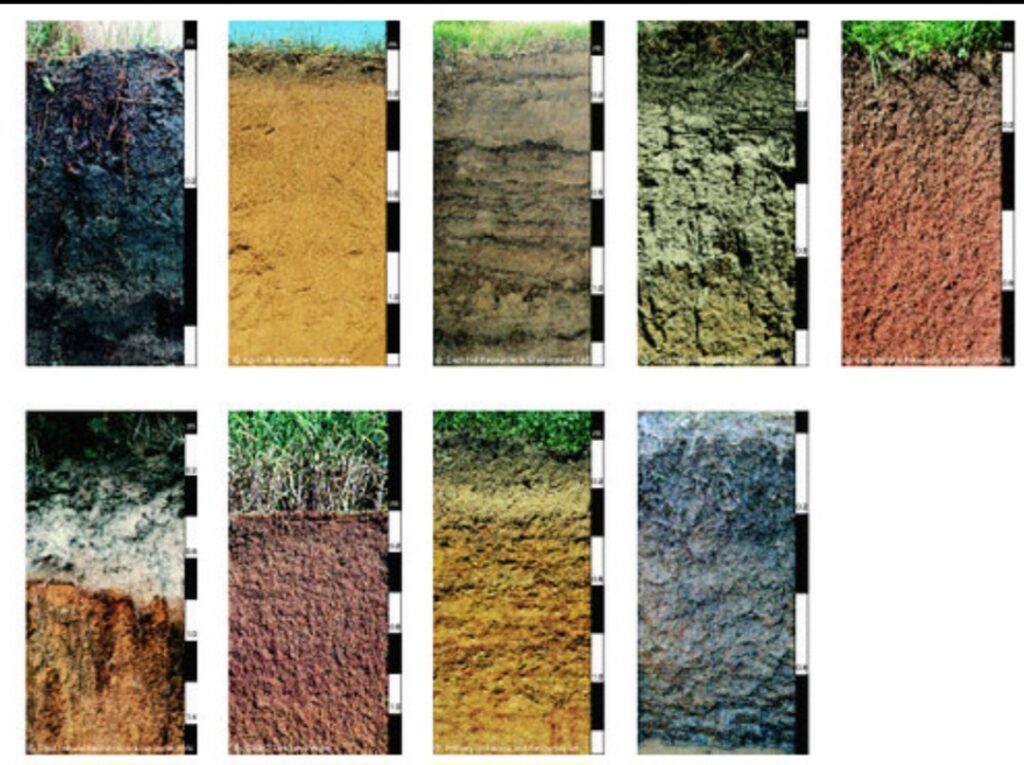
MINERAL MATTER: Soils are formed from rocks. These rocks are composed of various minerals that appear in various colours. Some of these minerals include hornblend, micas, chlorite, hematite etc. Soils formed from rocks containing these minerals exhibit the colour of the minerals. soils formed from rocks containing; quartz appear clear or transparent, feldspars appear white or pink, muscovite appear silvery and sparkly, magnetite appears metallic, and biotite and other mafic minerals appear black, chlorite appear green and hematite appear red. Therefore, minerals found in rocks determines the colour of the soil.
ORGANIC MATTER: Humus is formed from the decomposition of organic matter. When these humus are formed, the colour is black. Soils on which the decomposition of organic materials take place to form humus are imparted with colour that changes from brown to black. Also, the soil grains can be coated with the humus which turns the soil colour to black.
NATURE AND ABOUNDANCE OF IRON: Some soils contain iron. This iron appear in various colours such as; red, yellow, grey, and yellowish grey. When soils are partially filled with air and moisture, the iron turns to yellowish oxides changing, thus, the colour of the soil to yellow. When the soil is drained and dry, the iron turns to a reddish oxide, thus, changing the colour of the soil to red. When the soil is waterlogged under anaerobic condition, the iron is reduced and changes the colour of the soil to grey orsoil is formed. green or bluish-grey. Humid acid with connection with iron produces dark coloured soils. When a physical and chemical combination of iron and organic matter occurs, a brownish shade of
MOISTURE CONTENT: When moist soils dry up gradually, the colour of the soil darkens. Poorly drained soils possesses a bluish-grey colour with yellowish mottling. When the soil is dry, the colour brightens up.
REDOX REACTIONS: Redox reactions in soil involves reduction-oxidation processes. These two processes are due to changes in soil oxygen levels caused by water-filled pores or air-filled pores. When water fills pore spaces, creating a water pool on the surface, oxygen diffuses slowly into the water, and soil microorganisms uses up the existing oxygen supply causing reduced or anaerobic conditions. If reduced iron with the anaerobic soil condition reaches oxygen, like coming in contact with the plant root or near the top of the water table, the iron becomes oxidized, turning the colour of the soil to red.
ACCUMULATION OF MATERIALS: When calcium or gypsum accumulate at the soil horizons due to leaching, the colour of the soil found at that horizon will turn whitish especially with soils at semi-arid areas. Also, water can transport salts and cause salinity. The deposited salt will cause soils at that landscape to turn whitish. Along valley bottoms, the high rate of organic matter deposition do cause the soils of the valley to turn blackish, indicating a fertile soil.
HOW TO DETERMINE AND MEASURE SOIL COLOUR In determining and describing soil profile and landscape, soil properties including soil colour must always be observed throughout the soil profile. The soil colour can be determined when the soil is moist and not sliced or dry. Colour characteristics such as mottle size, percentage and contrast are usually observed and recorded. One of the tools used is the colour triangle.
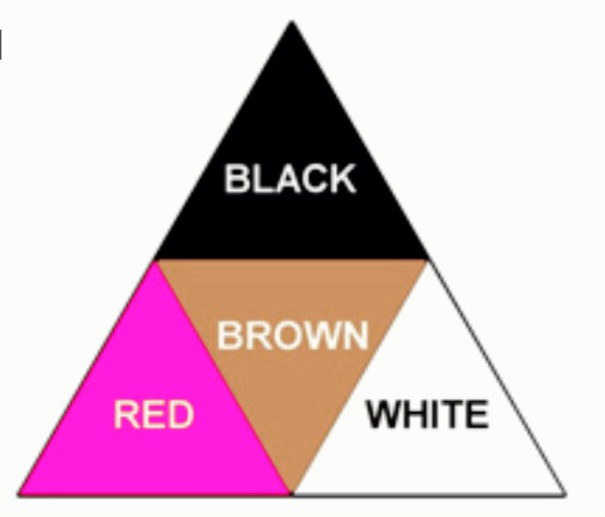
The colour triangle can be used to show the names and relationships between the influential colours.
Also, a system that involves the use of a specially printed colour charts (Munsell Soil Colour Charts) is an international standard tool. It divides colour into wavelength, lightness, and colour saturation.
Where a Munsell Chart is not available, simple names as listed in the colour triangle can be used.
The Munsell colour chart is a booklet formed from the complete edition of the Munsell Book of Colour (vide US Department of Agriculture Handbook No. 18: Soil Survey Manual) and consists of seven soil colour charts popularly called “Soil Collection Display 199.” Each soil colour chart (in the form of a loose leaflet) consists of different standard colour chips systematically arranged according to Munsell’s notations.
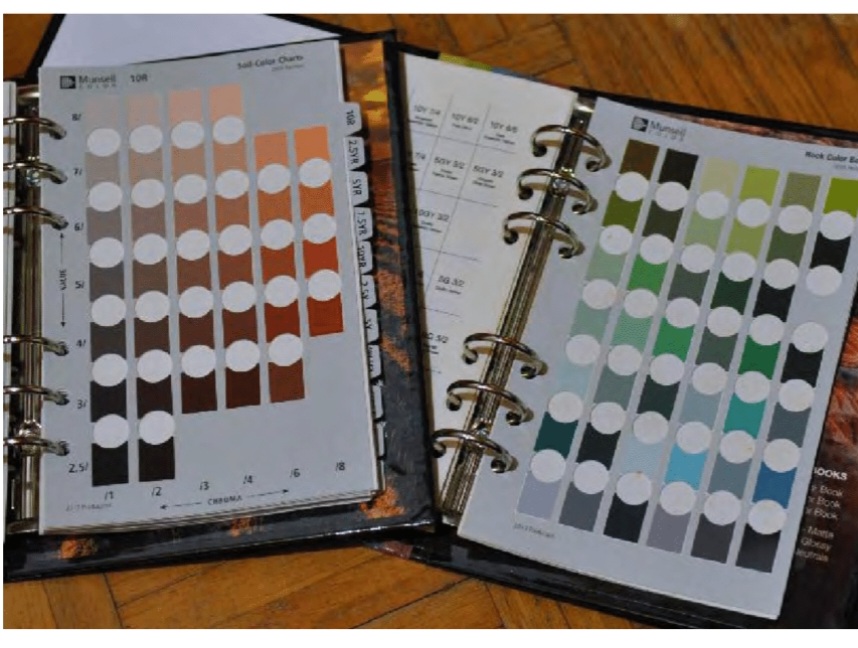
The Munsell notation system is subjected to various factors before reading can be possible. Some of the factors include: soil moisture condition, quality of light, the time of the day, and degree of crushing and the grain coatings. Another factor that can cause limitation is that the Munsell system with its hue, value and chroma notations cannot directly be used in numerical analysis.
To determine soil colours, soil samples are collected and compared with printed colour chips in the Munsell soil colour charts.
The colour system is expressed in terms of hue (basic color), value (lightness or darkness), and chroma (intensity of basic hue). These three simple variables combine to give all colours. Hue is the dominant spectral (rainbow) colour; it is related to the dominant wavelength of the light. Value refers to the relative lightness of the colour and is a function (approximately the square root) of the total amount of light. Chroma is the relative purity or strength of the spectral colour and increases with decreasing grayness.
Only air-dried bulk soil samples are used. But this had being subjected to various questioning because most of the colour of a bulk soil sample is due to the clay fraction, which contains clay particles intimately bound to soil humus (forming the clay–humus complex) and clay particles coated with humus.
READING OF THE MUNSELL COLOUR CHART
Standard notation used to indicate a soil’s colour is as follows and it is formatted in the following ways:
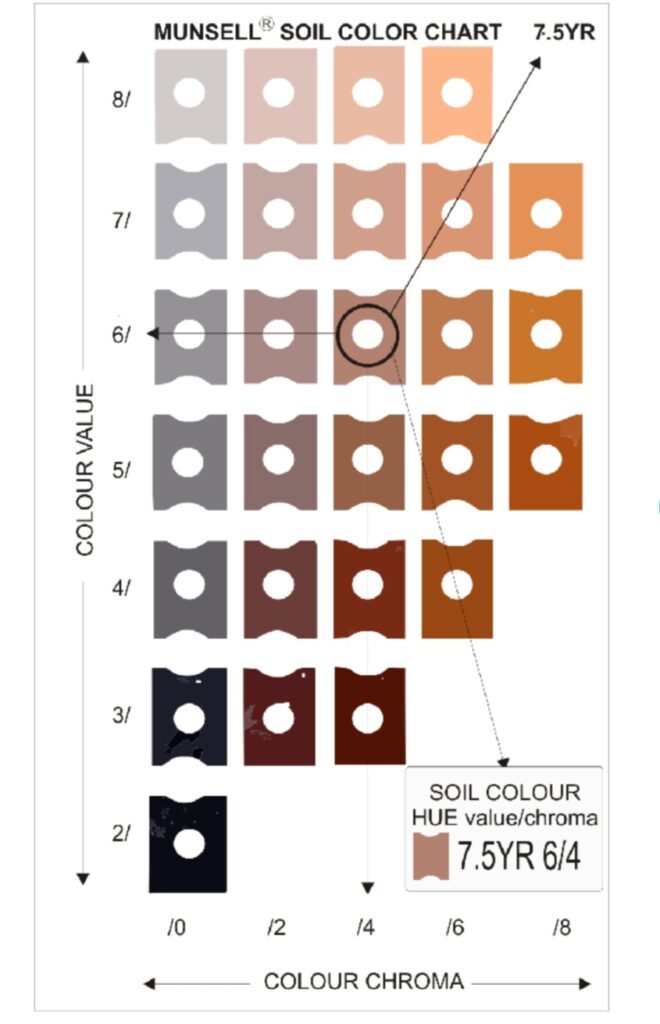
From the page chips in fig 5;
Page/Value/Chroma
Example: 7.5YR 2/1
PAGE: mix of colours or hue. Each page represents a different hue. At the top left is the hue value. (7.5YR)
VALUE: lightness or darkness (/2)
CHROMA: intensity (/1)
Note that: Coloured mixture at varying amount of pigmentation materials can also occur in the soil to form a hue colour.
EFFECTS OF SOIL COLOUR
● Colour influences the rate of soil warming and cooling. Dark soils, irrespective of moisture content, absorb more heat than reflect them in light-coloured soils. Soils with higher moisture content and darker in colour absorb more solar radiation, but warm more slowly than drier soils do. This is due to the high specific heat of water—it consumes large amounts of energy during warming. Consequently, the surfaces of sandy and coarse soils both warm and cool more rapidly than clayey soils of the same colour.
Rapid cooling (heat loss) of the soil at night can generate significant warming of the air and fruit close to the ground. ● Reflective ground cover can slow warming of the soil during the spring but moderate its decline during the fall.
● living mulches, when decomposing can darken the soil, causing it to warm up as more heat are absorbed.
● Soil colour is an indicator of soil health. Farmers consider a healthy soil as one that is black, grey, brown, or dark-coloured whereas unhealthy soils are red, yellow, white or light-coloured.
● Soil colour reflects the predominant soil parent material in an area and the organic matter (OM) content.
● At forest areas, the dark surface colours of forest soils, particularly soils beneath productive hardwoods, are usually dark due to high amount of organic matter and organic matter coatings of mineral surfaces. Even low concentrations of this organic matter can create dark-coloured soils.
In conclusion, colour is important as characteristic for recognizing and describing soil profiles in all soil classification approaches. Additionally, colour can affect thermal properties of soils. Dark surface soil colours promote soil warming and biological activity in cool climates.
